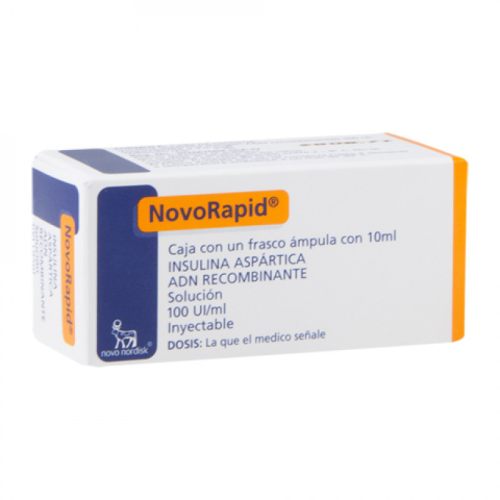Novorapid 100IU (Vial)
- Brand: Novo Nordisk
- Product Code: Novorapid 100IU (Vial)
- Availability: In Stock
-
$56.00
CLASSIFICATION
Hormone and Synthetic Substitute / Antidiabetic Agent
ACNE
No
WATER RETENTION
No
HBR
No
HEPATOTOXICITY
No
AROMATIZATION
No
MANUFACTURER
Novo Nordisk
WAREHOUSE
International Warehouse 2
SUBSTANCE
Insulin
,
Insulin is a potent anabolic hormone found in all humans, playing a crucial role in maintaining proper physiological function. While it is produced naturally within the body, those with diabetes often require supplemental insulin. Some athletes also use it to promote muscle growth. However, non-prescribed use can be extremely dangerous, and caution is essential.
Although insulin is naturally occurring in humans, exogenous insulin was first introduced in the 1920s. Initially, it was extracted from the pancreases of dogs and later from cattle and pigs. Despite concerns over its purity, this form of insulin was widely celebrated for its ability to save lives, especially in cases where diabetes could lead to fatal outcomes without treatment. By the 1970s, advancements in purification methods allowed for the introduction of synthetic insulin, with the first successful commercial version, Humulin-R, launched in 1982 and fully approved by the FDA.
Insulin's Functions and CharacteristicsInsulin, produced by the pancreas, is classified as a peptide hormone. It plays a vital role in managing glucose, amino acids, and fatty acids, as well as preventing the breakdown of glycogen, fats, and proteins.
For those with diabetes, there are two primary types necessitating insulin treatment. Type I diabetes, which is usually hereditary, occurs when the body cannot produce enough insulin. On the other hand, Type II diabetes, often linked to obesity, is characterized by the body’s inability to effectively utilize insulin despite its presence.
Insulin acts positively on the liver by stimulating the conversion of glycogen into glucose while inhibiting the conversion of non-carbohydrates into glucose. It also facilitates the transport of glucose into cells, thereby promoting muscle growth. Higher insulin levels have been associated with increased protein synthesis, bone density, and the production of Insulin-Like Growth Factor-1 (IGF-1), a powerful anabolic hormone similar to insulin.
Insulin also plays a role in elevating levels of Luteinizing Hormone (LH) and Follicle Stimulating Hormone (FSH), which can lead to increased testosterone production in the body, though this effect is relatively modest.
Insulin EffectsThe primary action of insulin is regulating blood glucose levels, which is critical for all individuals with diabetes. Its strong anabolic and anti-catabolic properties can also benefit various athletes. However, improperly used exogenous insulin can lead to significant fat gain and may result in life-threatening consequences if not managed correctly.
Despite its risks, some athletes find insulin beneficial for its anabolic effects, but it is essential to manage body fat levels. Elevated insulin levels can hinder the body’s ability to burn stored fat, necessitating a strict dietary approach to ensure glucose and protein are stored in muscle rather than fat cells. Administering insulin immediately after intense weight training is often the best practice, accompanied by food, as will be discussed further in the administration section.
When used appropriately, insulin can facilitate significant muscle growth in a short time. Many individuals struggle to manage fat gain, but it can be controlled under the right conditions. In performance settings, combining insulin with anabolic steroids and Human Growth Hormone (HGH) is frequently recommended to enhance growth while aiding body fat control.
Insulin Side EffectsThe most significant side effect of insulin use is hypoglycemia, particularly in performance scenarios where improper dosing can pose risks. While proper dosing generally prevents major issues for diabetic patients, hypoglycemia remains a concern for others. This condition occurs when blood sugar levels drop too low and can have serious, even fatal, repercussions if not addressed promptly.
Symptoms of hypoglycemia include:
If symptoms arise, consuming fast-acting carbohydrates, like candy or sugary beverages, can help reverse the effects. It’s crucial not to sleep after taking insulin; drowsiness is a sign more carbohydrates are needed. If severe hypoglycemia occurs, immediate medical assistance is necessary. Therefore, individuals should avoid administering insulin alone and always have a companion present for safety.
Severe hypoglycemia can lead to a diabetic coma or even death, highlighting the serious nature of this condition. Beyond hypoglycemia, insulin can also cause allergic reactions at the injection site, leading to swelling, redness, or tenderness, though these effects are rare. In some instances, more serious reactions like rashes or shortness of breath may occur and require immediate medical attention. Additionally, repeated injections in the same area can promote localized fat storage, so varying injection sites is important.
Insulin AdministrationWhen treating diabetes (Type I or II), insulin dosage varies widely based on individual needs, as there is no standard guideline.
In terms of performance enhancement, it's essential to understand that there are various forms of insulin with differing durations. The typical starting dose for performance enhancement is approximately 1 unit per 10 pounds of body weight, though first-time users should begin with a lower amount, around 1 unit post-workout, gradually increasing by 1-2 units as needed. If symptoms of hypoglycemia manifest, it likely indicates an overly high dose of insulin.
The most effective time to administer insulin is right after weight training, with immediate carbohydrate intake of at least 100 grams. This intake should occur approximately 15 minutes post-injection, along with about 40-50 grams of protein.
While 100 grams of carbohydrates is the minimum guideline, each individual's needs may vary, especially with higher insulin doses. Caution is advised, as it’s easy to overdo insulin. Therefore, starting at a lower dose and making gradual adjustments is recommended. After injecting insulin and consuming carbohydrates/protein, it's vital to keep fast-acting carbohydrates nearby to address any hypoglycemic symptoms promptly.
Regardless of whether symptoms appear, plan to have another meal soon after the initial post-injection nutrition.
Conclusion on Insulin UseInsulin is a critical hormone for health and functionality in the body. Though it can serve as a powerful tool for muscle building in the context of performance, its use carries inherent risks. Many individuals may find more satisfaction with their physique by avoiding insulin altogether, despite its popularity within advanced bodybuilding circles. It’s important to remember that those using insulin are often genetically gifted and often combine it with other performance-enhancing substances. Regular gym-goers using insulin might face challenges managing body fat levels.
Some athletes outside the bodybuilding community may also be drawn to insulin, as it remains undetectable in drug testing. Typically, these users maintain lower total doses while possibly combining it with HGH and minor amounts of testosterone and thyroid medications to navigate testing risks.

